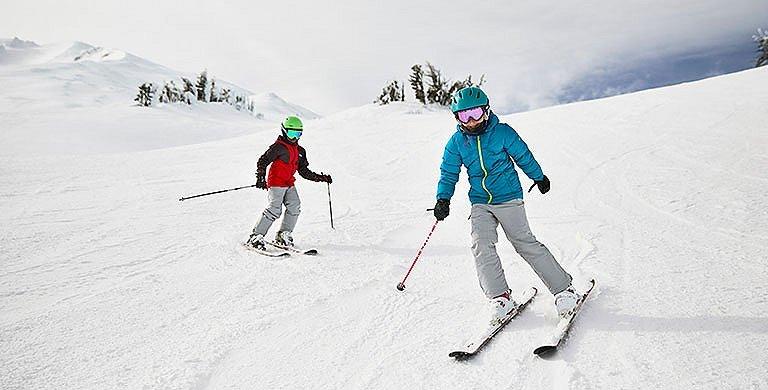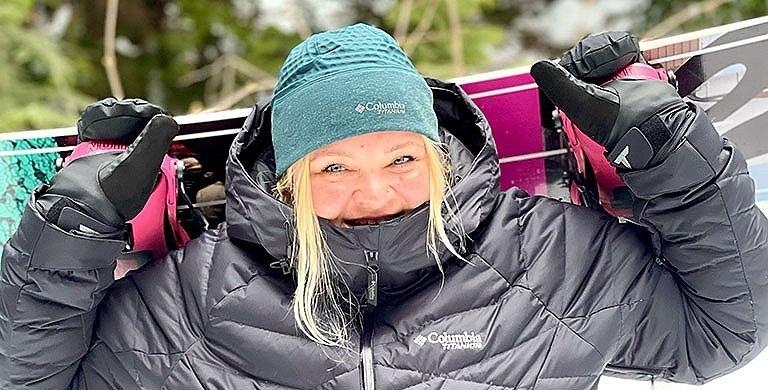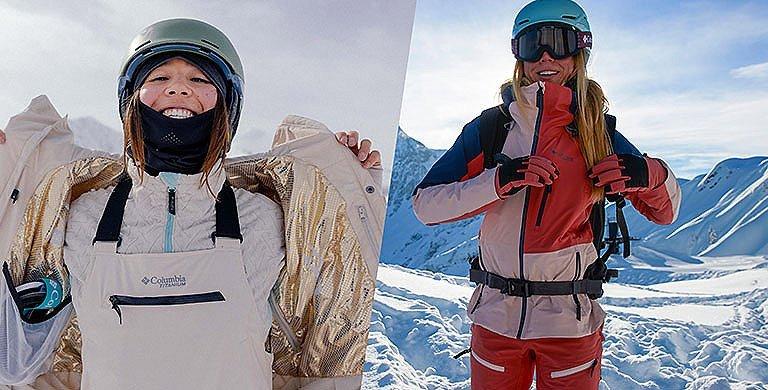SKI & SNOW
The Art of Upcycling Skis and Snowboards
A look inside the growing trend of repurposing old skis for furniture and décor
BY RACHEL CAVANAUGH
It’s a fact of life that every skier knows: at some point, even our most beloved skis and snowboards reach the end of their journey. The bases get chipped, the edges get dinged, and the cambers begin to wear out and collapse. Not only that, as technology changes, the shapes and materials become outdated.
So what do you do with your old skis and snowboards once they’ve reached the end of their life? Reselling aging skis may not be possible (or at least not very profitable), depending on their age and condition. And while manufacturers these days are beginning to make skis and snowboards in a more sustainable fashion, recycling programs for old gear are currently few and far between.
Often, upcycling your skis and snowboards is the best solution. In addition to being eco-friendly, upcycling projects have the added benefit of providing you with cool art or a functional home item such as a patio bench, wine rack, coffee table, or bookshelf.
To give you some ideas, we spoke with two everyday skiers who’ve turned their old ski gear into works of art, and provided a list of suggestions for your own upcycling projects.
So what do you do with your old skis and snowboards once they’ve reached the end of their life? Reselling aging skis may not be possible (or at least not very profitable), depending on their age and condition. And while manufacturers these days are beginning to make skis and snowboards in a more sustainable fashion, recycling programs for old gear are currently few and far between.
Often, upcycling your skis and snowboards is the best solution. In addition to being eco-friendly, upcycling projects have the added benefit of providing you with cool art or a functional home item such as a patio bench, wine rack, coffee table, or bookshelf.
To give you some ideas, we spoke with two everyday skiers who’ve turned their old ski gear into works of art, and provided a list of suggestions for your own upcycling projects.
Jordan Berde is the founder of Upcycled Ski, a Colorado-based craft business that turns old ski poles into wind chimes. One hundred percent of the profits from the project go toward supporting her fertility journey.
Jordan Berde: Upcycle Ski wind chimes
Jordan Berde’s passion for upcycling ski gear began several years ago when the Denver resident spotted a pair of unique wind chimes at a friend’s house that were made entirely from ski poles.
She recalls looking at them and thinking to herself, “They have a really cool design—I think I could do it even better.” Working at a ski shop, she knew how many junk ski poles people bring in every season, most of which no longer have any use.
“We end up throwing almost all of them away,” she says. “So I figured I could make these really cool wind chimes, and keep stuff out of the landfill.
As she considered ways to more fluidly integrate different graphics, she set off back home with a project on her plate.
Using a pair of $15 pipe cutters and some wooden discs she found on Facebook Marketplace, Berde strung together a colorful pair of wind chimes with a Kevlar cord. She assumed it would just be the one set for her and her wife to enjoy, but as soon as friends saw them hanging on her deck, they wanted one—and they were offering to pay her.
“I was like, ‘I can absolutely make you some, and you don’t need to pay me.’ But they insisted.”
After making several pairs for friends, someone suggested she sell them online. Although she wasn’t actively looking for a side hustle at the time, she and her wife had recently begun trying to have a baby, and their fertility costs were adding up. Insurance wasn’t covering most of the expenses, and they were looking for a way to fund the costly procedures required to begin a family.
Berde’s friends and family had been suggesting that she set up a GoFundMe page to accept donations for quite some time. However, she had never felt comfortable accepting charity.
That’s when a more fully fleshed out idea for her wind chimes emerged.
She recalls looking at them and thinking to herself, “They have a really cool design—I think I could do it even better.” Working at a ski shop, she knew how many junk ski poles people bring in every season, most of which no longer have any use.
“We end up throwing almost all of them away,” she says. “So I figured I could make these really cool wind chimes, and keep stuff out of the landfill.
As she considered ways to more fluidly integrate different graphics, she set off back home with a project on her plate.
Using a pair of $15 pipe cutters and some wooden discs she found on Facebook Marketplace, Berde strung together a colorful pair of wind chimes with a Kevlar cord. She assumed it would just be the one set for her and her wife to enjoy, but as soon as friends saw them hanging on her deck, they wanted one—and they were offering to pay her.
“I was like, ‘I can absolutely make you some, and you don’t need to pay me.’ But they insisted.”
After making several pairs for friends, someone suggested she sell them online. Although she wasn’t actively looking for a side hustle at the time, she and her wife had recently begun trying to have a baby, and their fertility costs were adding up. Insurance wasn’t covering most of the expenses, and they were looking for a way to fund the costly procedures required to begin a family.
Berde’s friends and family had been suggesting that she set up a GoFundMe page to accept donations for quite some time. However, she had never felt comfortable accepting charity.
That’s when a more fully fleshed out idea for her wind chimes emerged.
“If I can repurpose a ski pole that was bound for a landfill and turn it into something beautiful, sign me up.”
Jordan Berde, Denver, CO
“I'm not the type of person to ask for anything without giving something in return,” she says. “But when the wind chimes started taking off, I thought maybe I could use this platform to ask for contributions.
“Once I started telling people our story, the support was overwhelming. I was selling the chimes for $89, but once people heard about our fertility journey, they started donating $100, $150, $200.”
From there, Upcycled Ski was born. One hundred percent of the profits from the wind chimes go toward doctor’s bills and other fertility treatment costs for her and her wife.
In addition to helping them fulfill their dream of starting a family, Berde is happy to be creating a positive ecological impact. Since sales have ramped up on the chimes, she’s been able to salvage hundreds of ski poles from ski shops and rental stores throughout the country.
“If I can repurpose a ski pole that was bound for a landfill and turn it into something beautiful, sign me up. Being able to create art from somebody's trash, especially something that can be really peaceful and add to your experience in nature, that means a lot to me.
“It's brought me so much joy doing this—and it's something that anybody with a free Saturday could do.”
“Once I started telling people our story, the support was overwhelming. I was selling the chimes for $89, but once people heard about our fertility journey, they started donating $100, $150, $200.”
From there, Upcycled Ski was born. One hundred percent of the profits from the wind chimes go toward doctor’s bills and other fertility treatment costs for her and her wife.
In addition to helping them fulfill their dream of starting a family, Berde is happy to be creating a positive ecological impact. Since sales have ramped up on the chimes, she’s been able to salvage hundreds of ski poles from ski shops and rental stores throughout the country.
“If I can repurpose a ski pole that was bound for a landfill and turn it into something beautiful, sign me up. Being able to create art from somebody's trash, especially something that can be really peaceful and add to your experience in nature, that means a lot to me.
“It's brought me so much joy doing this—and it's something that anybody with a free Saturday could do.”
Ryan Maclay, a fine artist and commercial fabricator, hopes to install his decorative, eco-friendly ski trees at ski resorts throughout the country.
Ryan Maclay: ‘The Ski Tree Guy’
It’s no surprise that when Ryan Maclay learned about a 30-foot-tall Christmas tree in Ellicottville, New York made from 400-plus skis, he was intrigued.
The Pennsylvania resident is not only a lifelong skier, he’s also a fine arts major who studied functional sculpture and currently runs a custom fabrication business. The ski tree incorporated all the things he loves most into one project.
After examining how it was put together, he decided to try to make one of his own.
Maclay, who creates metal and wood installations for small businesses, lives on 24 acres. He convinced Roundtop Mountain Resort, a local ski hill where he works as a snow groomer, to donate part of its rental fleet to the cause. The effort resulted in a beautiful 20-foot tall installment boasting 210 skis.
It was so well-done, in fact, that Roundtop asked him to build another one at their ski resort.
“Being the mountain that I love and grew up on, I wanted to help them in any way that I can,” he explains. “So I decided to do a tree for them too, which I installed before the ski season started this year.
“I engineered it exactly how I wanted it to look with a more tiered look.
“I found it works better to have the skis all be different sizes rather than trying to cut skis down to make them work. So each tier of the tree is a different size ski. It starts up top with 70-centimeter kids skis and goes to 160s. It looks pretty neat, especially lit up with snow on it.”
The Pennsylvania resident is not only a lifelong skier, he’s also a fine arts major who studied functional sculpture and currently runs a custom fabrication business. The ski tree incorporated all the things he loves most into one project.
After examining how it was put together, he decided to try to make one of his own.
Maclay, who creates metal and wood installations for small businesses, lives on 24 acres. He convinced Roundtop Mountain Resort, a local ski hill where he works as a snow groomer, to donate part of its rental fleet to the cause. The effort resulted in a beautiful 20-foot tall installment boasting 210 skis.
It was so well-done, in fact, that Roundtop asked him to build another one at their ski resort.
“Being the mountain that I love and grew up on, I wanted to help them in any way that I can,” he explains. “So I decided to do a tree for them too, which I installed before the ski season started this year.
“I engineered it exactly how I wanted it to look with a more tiered look.
“I found it works better to have the skis all be different sizes rather than trying to cut skis down to make them work. So each tier of the tree is a different size ski. It starts up top with 70-centimeter kids skis and goes to 160s. It looks pretty neat, especially lit up with snow on it.”
“Next year I want to do the world record—a 32-foot tall tree.”
Ryan Maclay, Denver, CO
After he installed the tree at the resort, Roundtop posted a video of the tree online and, astonishingly, it was viewed over 25,000 times. The response quickly emboldened Maclay to conceive of a bigger vision for his project.
“The feedback was amazing. It blew me away,” he says. “It proved to me that this could be something I could do at more resorts.”
Now, the fine arts fabricator is hoping to install his trees at ski resorts throughout the country. And he’s figured out a way to streamline the process.
“I came up with a whole jig system and measurement system so I can build the pole offsite, tell the client exactly how many skis I need of each size, and then assemble it onsite.
“I made this contraption where I can put the skis together and then weld it all. The center of the pole has steel tabs that come out, which are attached similarly to the way they do lift towers. That was my inspiration.
“Next year I want to do the world record—a 32-foot tall tree.”
Rental shops get rid of their ski fleets every 8 to 10 years or so anyway, he explains. They can’t usually resell them because ski manufacturers only indemnify the bindings for a certain period of time. After that period expires, it can be risky for the ski resorts to sell them to the general public.
“Once they’re unindemnified, if someone reuses them without changing the bindings, it becomes a liability for the mountain. Most of the materials are plastic or fiberglass, so there’s no practical way of recycling them. They end up in a landfill.”
Maclay thinks his ski trees could serve as an innovative way for resorts to decorate their base areas in an eco-friendly manner.
“All of these mountains have these old skis sitting there, and they're going to end up throwing them away,” he says. How cool would it be for me to go to different ski towns and install these trees there?”
“The resorts always have little pieces of art as you walk through the village. Steamboat just built a sculpture this year that looked like Aspen trees. My ski trees would be another way to decorate and showcase art, but by upcycling something the resort already has instead of buying something new. It's a way that they can reuse something they already have in a cool fashion.
At the end of the day, Maclay says it’s his passion for the sport that makes him so excited about the new project.
“I love the ski industry. I've been a skier since I was three years old. I've skied over 2,500 days in my life. I absolutely love this sport. And I travel every year to ski. So to be able to install artwork in ski towns that looks cool and is also ecologically sustainable would be a dream for me.”
“The feedback was amazing. It blew me away,” he says. “It proved to me that this could be something I could do at more resorts.”
Now, the fine arts fabricator is hoping to install his trees at ski resorts throughout the country. And he’s figured out a way to streamline the process.
“I came up with a whole jig system and measurement system so I can build the pole offsite, tell the client exactly how many skis I need of each size, and then assemble it onsite.
“I made this contraption where I can put the skis together and then weld it all. The center of the pole has steel tabs that come out, which are attached similarly to the way they do lift towers. That was my inspiration.
“Next year I want to do the world record—a 32-foot tall tree.”
Rental shops get rid of their ski fleets every 8 to 10 years or so anyway, he explains. They can’t usually resell them because ski manufacturers only indemnify the bindings for a certain period of time. After that period expires, it can be risky for the ski resorts to sell them to the general public.
“Once they’re unindemnified, if someone reuses them without changing the bindings, it becomes a liability for the mountain. Most of the materials are plastic or fiberglass, so there’s no practical way of recycling them. They end up in a landfill.”
Maclay thinks his ski trees could serve as an innovative way for resorts to decorate their base areas in an eco-friendly manner.
“All of these mountains have these old skis sitting there, and they're going to end up throwing them away,” he says. How cool would it be for me to go to different ski towns and install these trees there?”
“The resorts always have little pieces of art as you walk through the village. Steamboat just built a sculpture this year that looked like Aspen trees. My ski trees would be another way to decorate and showcase art, but by upcycling something the resort already has instead of buying something new. It's a way that they can reuse something they already have in a cool fashion.
At the end of the day, Maclay says it’s his passion for the sport that makes him so excited about the new project.
“I love the ski industry. I've been a skier since I was three years old. I've skied over 2,500 days in my life. I absolutely love this sport. And I travel every year to ski. So to be able to install artwork in ski towns that looks cool and is also ecologically sustainable would be a dream for me.”
Maclay has built two ski trees so far—one on his own private property near Lewisberry, Penn. (pictured above) and another at Roundtop Mountain Resort.
More ways to upcycle skis and snowboards
Wind chimes and decorative trees aren’t the only way to repurpose old skis and snowboards. The sky's the limit when it comes to the different types of art, crafts, home goods, and furniture that can be made from decommissioned ski gear.
Below is a list of ideas from Forest Furniture, a Lake Tahoe–based business that upcycles old ski gear to make everything from lamps to coat racks to tables to chairs. Scroll through the list to get some inspiration of your own.
Below is a list of ideas from Forest Furniture, a Lake Tahoe–based business that upcycles old ski gear to make everything from lamps to coat racks to tables to chairs. Scroll through the list to get some inspiration of your own.
1. Deck lounge chairs
Use a set of four to six old pairs of skis to create a lounge chair for your deck or other outdoor space.
These colorful deck chairs made by Lake Tahoe’s Forest Furniture are perfect for lounging around the cabin after a long day on the ski hill. Photo credit: Forest Furniture
2. Countertop wine rack
With little more than a jigsaw and some varnish, you can morph your old skis into a cool wine rack for your kitchen countertop.
Turn your old skis into a countertop wine holder like these clever wine racks from Forest Furniture.
3. Wall-mounted wine rack
Take it a step further and create a full-blown wall-mounted wine rack out of an old snowboard.
If you have an old snowboard instead of skis, make a wall-mounted wine rack like the one above.
4. High back seats
Another option for repurposing old snowboards, these high-back seats can be used indoors or outdoors.
Upcycled snowboards can also be turned into sleek high-back seats for sipping coffee or nibbling on hors d'oeuvres.
5. Ski coat rack & mirror
A unique take on the popular ski coat rack, this mirrored version offers space in the middle of the two hooks to catch a glimpse of your reflection.
If you’re looking for a project with upcycled skis that you can hang on your wall, try making a coat rack. For an extra unique look, place a mirror in between them like the one pictured above.
6. Bottle openers
This easy-to-make wall-mounted bottle opener only requires the tip of one ski, along with a binding, and you’re ready to go.
You don't need a lot of skis to make a simple bottle opener like the ones above made by Forest Furniture.
7. Adirondack chair
If you have access to two old snowboards, upcycle them by making a pretty Adirondack chair, which can be used inside or outside.
For anyone wanting to make furniture, this Adirondack chair only requires two recycled snowboards.
8. Patio bench
If you have access to a higher volume of old skis, ideally a dozen or more, a patio bench is a fantastic way to repurpose them into a cool piece of furniture.
A patio bench is a great way to upcycle old skis if you have a dozen or more.
9. Floor lamp
There’s no better way to bring light to your room, along with a little ski-theme flair, than by crafting a floor lamp from old skis and poles like these ones from Forest Furniture.
Use your old skis, as well as your ski poles, to create unique floor lamps like the ones pictured above.
10. Table lamp
A slightly different take, this ski lamp uses old ski boots instead of skis or poles to provide extra light in your home.
These ski lamps, which are designed to sit on tables or countertops, can be made from upcycled ski boots.
Ready to hit the slopes? Check out our collection of ski and snowboard gear.



